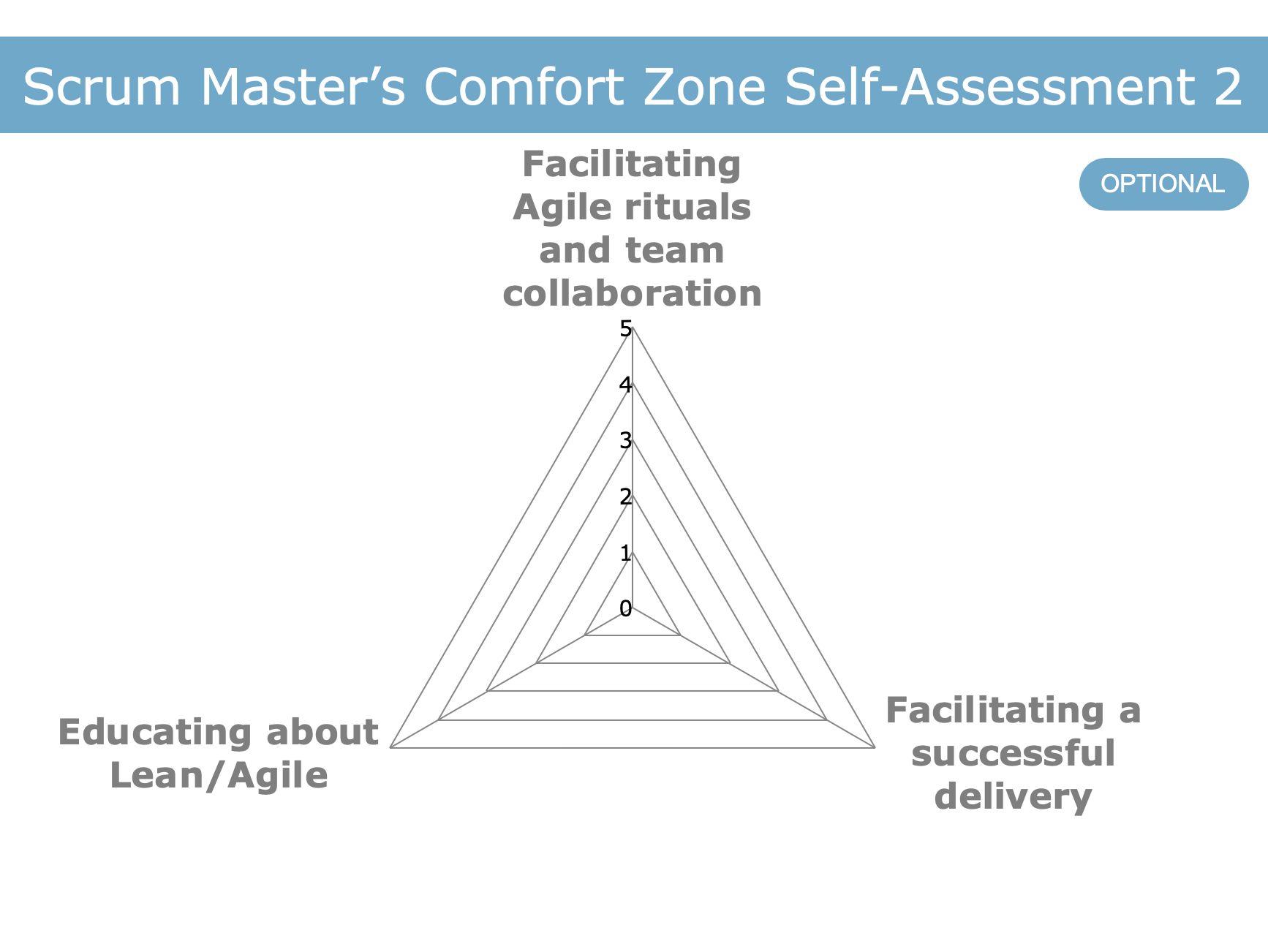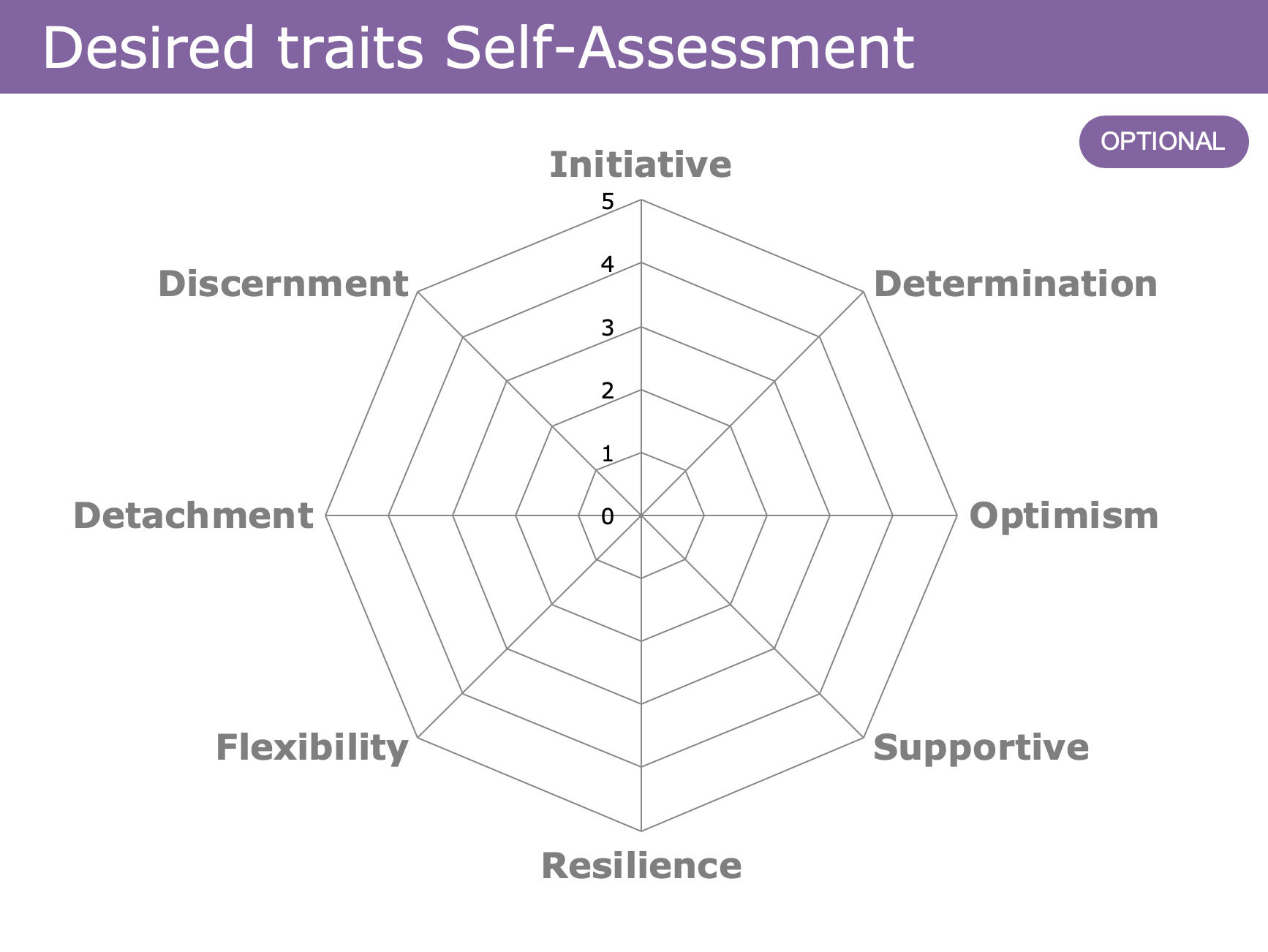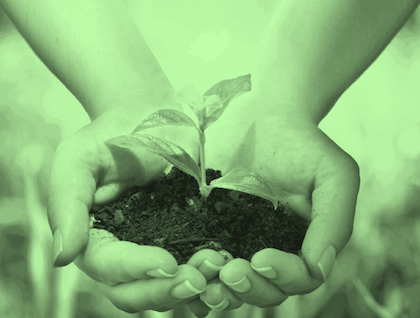Scrum Master Self-Assessment kit v3.2b
This kit assumes that you are already familiar with the Scrum foundations covered by the Scrum guide and related certifications. Its content is congruent (but not equivalent) with all the learning objectives outlined by Scrum Alliance and the course objectives defined by Scrum.org for all the steps of the educational path of Scrum Masters (Scrum Foundations, CSM, A-CSM, CSP-SM; and PSM I, PSM II, PSM III).
This kit focuses on the additional complementary competencies that enable you to:
- Facilitate the successful adaptation of Scrum to a team/organisation specific circumstances, maturity, and culture, when and where it is beneficial
- Complement Scrum with practices that go beyond the iteration and the single team setup
- Be a lean-agile polyglot, an all-rounded lean-agile professional, and have the necessary competencies expected in today’s job market.

Self-assessment Cycle
A) Increase your awareness of your strengths
Fill your radars using the levels definition and the descriptions where available. The Competencies radar is the primary one, the others are optional.
B) Choose where and how to improve
Identify where you really want to improve and practice as well. Have a mentoring conversation around your radars, to identify improvement actions.
C) Track your progress, rinse and repeat
Carry out your improvement actions. Collect feedback to assess your progress. Update periodically your radar, follow-up with a mentoring conversation, rinse and repeat.
Handy tips
For your personal use
0) Use it for your personal development: find someone in your community and pair-mentor each other. Or use it for career development: find someone in your organisation to be your mentor.
1) The radars are mainly a placeholder for a conversation between you and a mentor, exactly like user stories are for a conversation between the customer and the development team.
2) The levels (0-5) are relative to you and personal: using them to compare two SMs makes no sense, it would be like comparing velocity between two teams. The purpose is to identify and visualise options for improvement and to track your progress over time. Rating yourself too high or too low would defeat the purpose. The shape of your radars resambles your profile as SM and is unique to you and your style.
3) You can print or hand-draw the radars, or you can download the PowerPoint deck and edit the radar’s chart adding your data and saving the deck.
For a department or an organisation
1) When the radars are used in your organisation, consider having the Scrum Masters’ Community of Practice adapt and/or rewrite them to fit your organisation context and circumstances.
Comfort Zone radars


Levels guideline
Level 0: Outside and far away from your comfort zone. Feels very uncomfortable.
Level 1:
Level 2: At the boundary of your comfort zone.
Level 3:
Level 4:
Level 5: At the centre of your comfort zone. Feels like home.
Scrum Master’s Competencies radar

Levels guideline
Level 0: Tourist
I never heard about that!
Level 1: Just starting (e.g. just got out of the CSM class, limited previous experiences)
I act following predefined rules, my approach is limited and not very flexible.
Level 2: Improving
I incorporate aspects of the situation and the context, and I adapt my approach accordingly.
Level 3: Capable
I act consciously taking into account long-term goals and plans.
Level 4: Expert (e.g. good listener, collaborative with other SMs, confident/effective with multiple teams, engaged with stakeholders from the broader organisation)
I see the situation as a whole and I act from personal conviction, invent and introduce small-scale innovations; my personal improvement is continuous and self-sustaining.
Level 5: Globetrotter (e.g. I wrote the book)
I have an intuitive understanding of the situation and I zoom-in on the central aspects, I have an easy and creative way of doing things, I invent and introduce large-scale innovations to deal with truly unique situations.
Scrum Master Competencies description
Lean-Agile Practitioner
I enact
the Lean-Agile values, principles, and mindset. I know and have hands-on experience
with Agile, Lean software/product development, Scrum and other
frameworks
such as Kanban, Extreme Programming
(I know the main agile technical practices, I know software craftsmanship, I
understand technical debt), and models such as Empirical process
control, Cynefin, Lean Thinking, Systems Thinking, Complex Adaptive Systems,
etc.
I
master
several Lean-Agile practices. I know several techniques to manage
self-organising systems. I understand the agile approach to
product envisioning and development, and to business strategy. I know Lean UX
and Lean Startup.
I have practised Agile and Lean in a variety of different teams, organizations, and industries. I’ve multiple direct experiences of what good really looks like in Lean and Agile.
I collaborate effectively with other Scrum Masters in my unit to learn, tackle common problems, and to agree on common approaches where beneficial. I’m an active member of the Agile community. I attend conferences and meetups. I’ve read several seminal lean/agile books.
Teaching & Mentoring
I teach and mentor effectively team members in Lean-Agile mindset, principles, and practices, on Scrum and Agile rituals, on deep collaboration, on giving and receiving effective feedback, and co-creation. I’m experienced in creating, organising and delivering training sessions.
I teach and mentor BAs, POs and also business people, managers, and stakeholders on Product Ownership, agile requirements, agile estimation, and agile roadmapping.
I negotiate effectively my role’s and the mentoring relationship’s goals with the sponsor and the team. I’ve read books on training techniques.
Facilitation
I effectively facilitate the team’s
agile rituals. I effectively facilitate team building, discussions, common
understanding, and collective sense-making. I navigate and resolve conflicts,
facilitate collective consensus building, and facilitate collective decision
making.
I effectively facilitate large ad-hoc workshops including bigger and complex ones such as the Inception Workshops.
I tell less and I practice active listening more, with curiosity, openness, and without being judgmental. I give full undivided attention when listening. I perceive what has been told, the subtext, as well as emotions, body language, posture, tone, the surrounding context and the environment.
I’ve read seminal books on facilitation, visual facilitation, and agile facilitation.
Delivery facilitation
I support as a facilitator the team’s effort to achieve a successful delivery. I update tracking data, I visualise the work remaining, I facilitate the removal of any blocker, I help the team to look at the whole end-to-end picture.
I facilitate team’s practices and rituals at the release level, e.g. the definition of delivery success criteria, the definition of the delivery constraints using the agile triangle, technical feasibility, business viability, high-level sizing of the scope, high-level prioritisation, risk/uncertainty estimation, RAIDs identification, etc
In my facilitation I adopt at Servant leadership style toward the team. I’ve read relevant literature, for example about servant leadership, Cynefin framework ad decision-making tool, radical management, management 3.0, etc.
Facilitating dependencies management and cross-team collaboration
I facilitate the team in identifying
cross-team and external dependencies, both technical, business and people
related. I encourage them removing incidental dependencies, relaxing and
dealing with the essential one.
I effectively facilitate cross-team coordination around dependencies employing suitable cross-team rituals and suggesting ways to organise the work in ways that suit the circumstances (e.g. using queues with SLAs, buffers, staggered sprints, or synchronised sprints).
I effectively facilitate work that involves multiple teams. I facilitate cross-team planning, collaboration and communication around the dependencies, progress visualisation, blockers identification and removal.
Whole org End-to-end Agility
I have the knowledge and direct
experience of several traditional and modern organisations, their structure
(e.g. hierarchical, networked, flat),
functions (e.g. PMO, Marketing), governance and
culture.
I’ve direct experience as well as a good understanding of how different organisational cultures fits with Scrum and more in general with Lean and Agile.
I’ve direct experience of organisations going through a paradigm shift from a traditional/Taylorist mindset to a Lean-Agile mindset, and toward business and organisational agility.
I understand and I confidently apply lean and agile theory for organisations, including for example systems dynamic, and complex adaptive systems, organisational development and organizational change theory.
I’m capable of collaborating with and supporting the agile journey of various stakeholders and senior leaders from various functions outside IT and from the broader organization.
Personal Traits radars


Levels guideline
Level 0:
The trait is absent or the opposite trait is present
Level 1:
The trait is present in you as much as in most of the people around you
Level 2:
Some acquaintances, friends or co-workers would mention the trait when asked about your traits. You can mention some events and behaviours where you exhibited the trait.
Level 3:
You consistently exhibit the trait over time and consistently whenever it’s appropriate. You can mention several events and behaviours where you exhibited the trait. The opposite trait is not part of your coping mechanism even under stress.
Level 4:
Almost everyone recognises it as one of your key strong traits.
Level 5:
You are a role model for the trait.
Desired Traits description
Initiative
The ability and tendency to assess and initiate things independently. The ability to act first or take charge on one’s own without first being requested to do so or before others do. The ability and tendency to initiate: to start an action, including coming up with a proposal. The readiness to embark on a new venture. Having a fresh approach to something; a new way of dealing with a problem.
Flexibility
The willingness to change or compromise. The quality of bending easily without breaking.
The extent to which a person can cope with changes in circumstances and think about problems and tasks in a novel, creative ways. Even in the case of stressors or unexpected events.
Optimism
Hopefulness and confidence about the future or the success of something.
A disposition or tendency to look on the more favourable side of events or conditions and to expect the most favourable outcome.
Resilience
The ability to properly adapt to stress and adversity.
The ability to recover from or adjust to misfortune, damage, change or a destabilizing perturbation in the environment. The ability to become strong, healthy, or successful again after something bad happens.
Determination
The firmness of purpose.
The quality that makes someone continue trying to do or achieve something difficult.
Having a positive emotion that involves persevering towards a difficult goal in spite of obstacles.
Detachment
The state in which a person overcomes his or her attachment to desire for things, people or concepts of the world and thus attains a heightened perspective.
The ability to manage emotional boundaries, to find the proper level of emotional engagement, in order to allow the space needed to rationally choose, maintain the integrity and avoid undesired impact by or upon others.
The ability to maintain neutrality, serve the agenda of those we are supporting, reduce their dependence, not colluding with the desire to accommodate limitations without attachment or judgment.
Discernment
The ability to obtain sharp perceptions and to judge well.
The ability to see and understand people, situations and things clearly and intelligently.
The quality of being able to grasp and comprehend what is obscure such as hidden context, implicit assumptions, intangible things, mutable and uncertain circumstances.
Supportive
Providing encouragement, emotional help, and support. Being informative. Being sympathetic. Having and showing concern. Appreciating present strengths, successes, and potentials. Recognizing and searching the best in people and helping them to envision what they can achieve.
Undesired Traits description
Directive
Preference to direct others, to assign tasks and supervise people and resources.
The propensity to define and enforce standards, guidelines and rules.
The predilection to positions of authority in a top-down hierarchy.
Defensive
Being concerned with guarding against the threat of criticism.
Perceiving openness, transparency, fluid roles and responsibilities, honest feedback as threats.
Being anxious and avoiding to exit the comfort zone, to express opinions or take positions in public.
The feeling that one has to justify his/her behaviour and act as though questions are attacks on him/her.
Judgmental
Having or displaying an overly critical point of view.
The conviction that when there are 2 different opinions or points of view, one must right and the other must be wrong; and that most problems admit one optimal solution.
The tendency to think that a truth, a value or a best practice does not admit exceptions and does not depend on contexts, circumstances or personal preferences.
Low threshold to frustration
Getting easily stressed.
Getting irritated or angry when facing small frustrations that would just annoy other people.
Reacting disproportionally to adversities.
Favouring immediate pleasure or avoidance of pain over avoiding long-term stress and defeatism.
Resources
Agile Alliance Resources: https://www.agilealliance.org/agile101/
Top 100 Agile Books: https://www.goodreads.com/list/show/41715.Top_100_Agile_Books
30 Scrum Books: https://www.scrum.org/resources/blog/30-books-scrum-masters
Agile Library: http://agilelib.net/
Agile resources selection by Mike Cohn https://www.mountaingoatsoftware.com/agile
Other agile resources selections:
– http://www.hanoulle.be/books/
– https://tobiasmayer.uk/scrum/academy
– https://www.sourcecell.com/scrumResources.html#checklists
– Agile-Fundamentals-reading-list-per-role (pdf)
Small selection of Trainings
-Workshop: Lean Development Workshop, Tom and Mary Poppendieck
-Workshop: Cynefin & Sense-Making, Dave Snowden
-Workshop: Lean UX in the Enterprise, Jeff Gothelf
-Workshop: Coaching Self-Organising Teams, Joseph Pelrine
-Workshop: Training From the Back of the Room, Sharon L Bowman
-Workshop: Coaching Agile Teams, Michael K. Spayd and Lyssa Adkins
Conferences, Meetups, Lean/Agile community events: search in your area.
About these radars
The most valuable part of these radars is the approach to continuous personal development toward your self-actualisation, supported by recurring mentoring conversations.
You are encouraged to personalise and even rewrite the radars, based on your specific needs and circumstances, possibly with some guidance from a mentor.
These radars have been drafted with the assumption that:
– Good Scrum Masters are Lean-Agile polyglots and master a variety of frameworks and techniques beyond Scrum
– In real-life scenarios where Scrum by the book is not enough, it is important to master the theory behind Scrum and Agile (e.g. empirical process control, complex adaptive systems, lean thinking, etc.)
The radars are based on several years of experience in the field, observations made working and collaborating with many Scrum Masters in many organisations and participation in several SMs CoP, and on the feedback received.
Thanks for their feedback and suggestions
- Laura Re, Coach and Trainer, London: futurefocusdevelopment.org
- Marijn van der Zee, Scrum master, Netherlands
- Noel Warnell, Scrum master and agile coach, London
- Guilherme Motta, agile coach, BRAZIL
- James Willis, Scrum Master and Agile Team Lead, UK
- Anna Zalutska, agile coach, Latvia
- Corrado De Sanctis, Scrum Master and Agile coach, LONDON
- Jamie Panton, agile delivery manager, UK
Desired and undesired traits have been inspired by a post from Esther Derby.
Download this deck from Slideshare
You may also like:
– Lean/Agile Coach self-assessment radars
– Agile Delivery Manager skills self-assessment radar

Elevate your Agility.
See how we can help.
You, your team, your organisation.